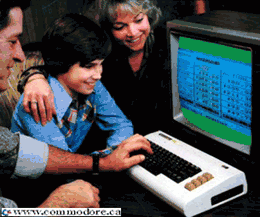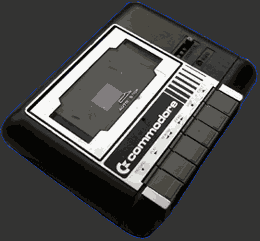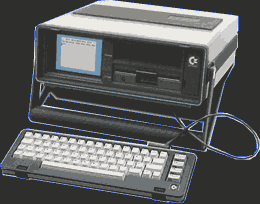THE FIRST HOMECOMPUTER: THE COMMODORE VIC-20
To own a computer today is almost as normal as owning a coffe machine or a fridge but
to own a computer back in 1981 was quite an obscure thing and really didn't make much
sense, mainly for two reasons: the machines were extremely expensive and you couldn't
really do much with them. So an IBM PC Jr.
of that time could be used for programming
but
with the
limited graphics (only 2 colours, black and white/green/yellow) and no
sound
that was
more a thing for nerds and scientists. Or an ATARI game console was
more a
bleeping toy displaying some
pixels on your TV and generally a thing for kids.
So in 1981 the Commodore company came up with the idea to bring out a computer for
the mass market, which led to the first-ever homecomputer, the VIC-20 (named after
its revolutionary Video Interface Chip). This machine captured the imagination of
many enthusiasts because of its very user-friendly BASIC language, nice color
graphics, programmable sound, comfortable keyboard, and the fact that it could
directly connect to compatible disk drives and printers without expensive expansion
modules and interfaces - an that for a price of $400 only! Since a machine like this
could suddenly be used for many purposes like word processing, bussiness calculation,
education and - not to forget!
- gaming, it turned out a tremendous commercial
success. The VIC-20 (with a 1 MHz CPU) presents something like a Model T Ford for
home computers and was the first one of which more than 1.000.000 units were sold.
Compared to a - vastly more expensive! - IBM PC the VIC-20 was much superior in all
aspects so Commodore was receiving only real competition from the Atari 400 and 800,
the
Texas Instruments 99, the Radio Shack TSR80 and the Apple 2 computer.
Despite the rivalry between these 8-bit manufacturers much of the credit for
innovation goes to Commodore largely because Commodore consistently pushed the price
down and because the Atari and Apple computers used the Commodore 6502 processor as
their main microprocessing chip.
But around 1983 rumours got around that Commodore was working on a vastly more
powerful machine called 'VIC-64', later renamed 'C64' and many people experienced
for a first time the today ever-present phenomenon of UPGRADING: within a very short
time the value of the
old machines dropped rapidly due to upcoming improved
technology.
THE COMMODORE C64
A large factor in the success of the C64 was its amazingly versatile, futuristic and
user-friendly design. The fact that this computer had more memory, a nicer keyboard,
and was easier to interface with peripherals than most computers of that era - it had
an RF-video output and could be connected to any TV thus no additional monitor was
needed - made it
so it was and still is (in many ways) an ideal computer.
An interesting side story to the The COMMODORE BASIC Operating System: this OS was
written by two guys named Bill Gates and Paul Allen for their upstarting Micro-Soft
Corporation (later renamed Microsoft Corporation) and was the only software license
ever granted by Microsoft to any company for all products regardless of the number of
copies used. Not many people (including me) knew that.
The combination of advanced Commodore chips allowed some amazing capabilities. The
C64 utilized the Commodore 6510 microprocessor chip (an advanced version of the
chip which had been used in the Vic 20, Apple 2, and Atari models), had
16 color
graphics with sprite capabilities due to the Video Interface (VIC) Chiphad and the
revolutionary sound via the 6581 Sound Interface Device (SID) chip and was
probably the first home computer to be able to emulate the human voice without
additional hardware! At the same time the early IBM home computers were non-color
and non-graphic machines with sound that amounted to little more than beeping.
When the C64 hit the market it was available for $595 but that price was reduced
to $300 within months and soon to $200 which totally heated up customer interest and
led to
its enourmous sales. Until today the C64 is the most sold computer ever - near
10 Million by the end of the 80ies. Many
after-market and 3rd party manufacturers
subsequently began to create and market
Commodore-compatible software, hardware,
books, and accessories in an effort to get
in on the growing industry. Many of the
present software and hardware giants got
their start during those days. Microsoft's
Multiplan became a very popular
spreadsheet for Commodore. Other companies such as
Electronic Arts, Accolade,
Activision, Epyx, Access, Infocom, Mastertronic, etc. soon
became household words.
When
smaller companies and private individuals began programming their own software
for the C64 the concept of shareware and freeware emerged
and many Public Domain
programs came out which greatly added to the availability of affordable software. But
this was also the time in which Software Piracy has its roots, mainly induced by
unnecessary high prices. Soon the big software manufacturers came up with copy
protection schemes which some individuals, called Hackers, successfully
bypassed. Due
to the availability of modems for the C64 this knowledge on hacking could be
exchanged worldwide - and in this way important pioneer work for today's internet was
done in
the
process.
THE DECLINE OF COMMODORE
When in the mid 80ies the C64 lost ground to newer Macintosh (APPLE II) and IBM
models
a company named Berkeley Softworks created a new operating system for the
Commodore 64 (and 128) called GEOS which became immensely popular and breathed new
life into Commodore's 8-bit market. As a graphical operating system, GEOS ripped-off
its look-and-feel from the novel Apple Macintosh. Circa 1986, Mac-like gadgets,
icons, menus, desktops, and windows were a fresh phenomenon in personal computing.
These interfaces made technology much easier to use. GEOS stands for Graphic
Environment Operating System and came
with the Geowrite word processor program and
the Geopaint graphics software (named
after Macwrite and MacPaint). So C64 users were
thrilled that they could have a
computer which could perform nearly like the
Macintosh - for just a small percentage
of the price of a Mac - while still having
color graphics and sound better than any
Macintosh. But this was only possible
because Berkeley was able to squeeze everything
out of the Commodore 64's limited
memory and disk capacity with their highly
efficient programming. So a full line of
GEOS-based programs ensued.
But GEOS had two major flaws: the concept of it was actually a bit too sophisticated
for a 8-bit machine. After all a C64 has absolutely limited screen space and many
unnnerving floppy changes were necessary. The second problem was the virtually
uncrackable copy protection, which kept it out of the hands of pirates and the
distribution of the OS and all following programs was so limited to actual buyers. As
a comparison: if WINDOWS wouldn't have been distributed that widely via piracy it
never
would have reached its position today - all Windows software included. The same
goes for Windows' machine platform, the PC. So when in the late 80ies due to the
competition with Commodore the PC industry had to lower their prices dramatically and
was forced to improve their quality Commodore lost more ground and the company's
downfall became imminent. Poor management, support, marketing (the chapter of the
AMIGA 500), lack of dominance in the business sector and competition from other
gaming systems did the rest to them and Commodore had to shut down in 1993/94.
What stays are a great number of incredible achievements that laid the foundation for
the
computer and its software as we know it today. Commodore was the number one
innovator in many fields and lots of later innovations, concepts or ideas emerged
from the situation created by them. Such as computer music. (continued...)












